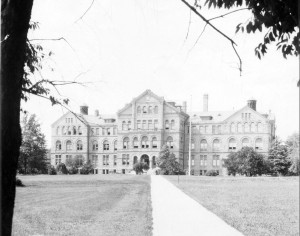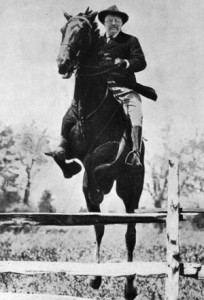
Good Old McMahon Hall. Built in 1892 to house the school of philosophy, arts and sciences, and the school of social sciences, this Romanesque structure has had many occupants across the last 123 years. Sociology, biology, languages, math, a plethora of administrative offices—all have been in, out, and back again across the decades. The second building erected as part of CUA’s young campus, McMahon was made possible by a $400,000 (yes, buildings were a lot cheaper way back then) donation by Monsignor James McMahon, an Irish-born priest who had served as a New York pastor. The Monsignor lived in the building in his retirement, passing his final days there until his death in 1901 at the age of eighty-four.
McMahon would surely have had good company there, not only with the professors and students who roamed the halls and occupied the classrooms, but with Giuseppe Luchetti’s imposing Leo XIII, a 12-foot high marble statue with which Theodore Roosevelt explicitly requested an audience.

Yes, that’s correct, the 26th president of the United States requested a visit with a statue on the CUA campus. Apparently, Maurice Francis Egan, a professor of English at CUA from 1896 until 1907 and a good friend of TR’s, had bragged up the statue. One morning President Roosevelt was out for his morning ride and ran into several CUA students doing the group singing they did every Sunday morning under the windows of Caldwell Chapel after mass (a tradition that should be revived?). TR rode up with two early versions of Secret Servicemen on horseback and asked the boys “what buildings are these?” The boys told him and he asked them where the statue of Leo XIII Professor Egan had told him about was. And the awed students escorted him to the statue, which apparently so impressed the President that he gasped. Small world, that Washington of the 1900s.[i]
The statue was given to the University as a gift in 1891 by New York philanthropist Joseph Florimand Loubat. Pope Leo XIII is pictured here in the sedia gestatoria. This was the ceremonial throne on which the popes were carried among crowds before the popemobile made its debut in the late 1970s. His gesture is the urbi et orbi, a blessing bestowed on Rome and the world.[ii] It has been in McMahon’s foyer since its earliest days. And it belongs there. Firstly, because Leo XIII was the pope not only when the building was erected, but when CUA was founded. Indeed, Leo is a founder of CUA as it was he who approved the establishment of the University when petitioned by the American bishops for its establishment in 1885. He didn’t need much persuading—the Pope encouraged the establishment of the school, which was was formally approved in 1887.

CUA’s connection to the papacy is direct: this is a pontifical university, meaning that it is a school established by the Vatican, and functions directly under its authority. As such, CUA confers ecclesiastical degrees accredited and certified by the Holy See in Rome.
[i] Frank Kuntz, Undergraduate Days, 1900-1907, (Catholic University of AmericaPress, 1958) 41-47.
[ii] Patrick H. Ahern, The Catholic University of America, 1887-1896 (Catholic University of America Press, 1948), 90-91.
